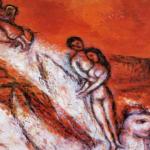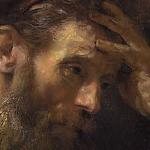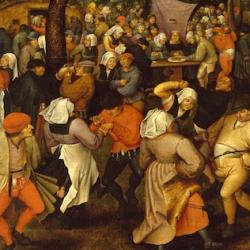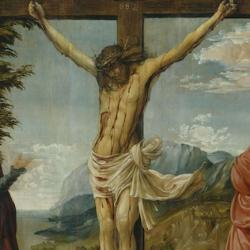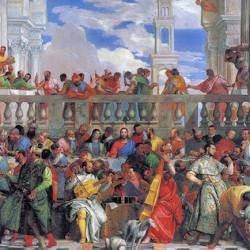Max Thurian (Mary, Mother of All Christians) has a wonderful treatment of Mary’s role at the wedding feast at Cana.
He starts by noting some of the symbolic dimensions of the event. The wedding takes place on “the third day,” initiating a theme that runs through the rest of John’s gospel (several times Jesus acts “after two days). The third day is also the seventh mentioned day in John 1-2, completing a creation week with a Sabbath feast.
Thurian points to the wine-feast of Proverbs 9 and of Isaiah 55, and notes Old Testament passages that highlight the marital relationship between Yahweh and Israel.
In this setting, “the presence of ‘the Mother of Jesus’ on this occasion is certainly not without meaning and importance.”
Thurian links this episode to the other moment when Mary appears in the gospel, “at the foot of the Cross, when the decisive Hour of the death of the Messiah will have arrived. Both here, and in the other place, the gospel writer gives her the title of ‘Mother of Jesus’ (or ‘Mother,’ four times at Cana, four times at the Cross); he thus underlines her close relationship with Christ as being the human Mother of the Son of God.”
Yet, at the beginning of the wedding, “Mary is not in the group of the disciples; she is not just one of them; she is separate. She has her own part in the setting of this event; she is already there. It seems that the gospel writer is wanting to record a change in Mary’s relationship to Christ in the course of this marriage feast at Cana.”
Mary has completed her role as theotokos, as God-bearer, Mother of God, when Jesus enters “upon His own ministry and now she is alone, humanly speaking, and it is alone that she comes, of her own right, to be present at the first revealing of the glory of Christ.” Her relationship to her Son is about to change, a change signalled by Jesus’ use of “woman” instead of “mother” and by what appears to be the rude question “What between you and me?”
That changed relationship is indicated at the end of the episode when “the persons who had come separately from two different directions go out together as one.” After Jesus first reveals His glory, “Jesus, His Mother, His brethren, and His disciples form a united group in which particular members will no longer be distinguished.”
That’s the movement that Thurian traces throughout the interchange between Jesus and Mary. She begins with a mention that the wine has run out. Thurian sees this as expressing “a hope of miracle, and is even a prayer that one might be performed.” She knows that her son is capable of miracles. Throughout John’s gospel, though, Jesus is reluctant to perform miracles. He knows what is in man, and knows that men will attach themselves to Him as a wonder-worker instead of as Savior and Lord.
Mary too needs to be corrected. She has to move beyond her very human request to see something deeper about Jesus’ Messianic vocation: “In her act of faith and in her prayer, Mary appears as one who represents humanity in difficulty and Judaism in its messianic hope; she is the type of humanity and of Israel which are awaiting their deliverance, a mysterious deliverance for humanity, a messianic but still very human deliverance for Israel. Faced with the plea of the nobleman, Jesus will warn those around Him about signs and mighty works, in order to awaken a purer faith which does not demand miracles. The reply of Jesus to His Mother must first be interpreted as a warning and an appeal to a more surrendered faith: ‘What have I to do with thee, woman?’ It is, let me repeat, not a refusal to work a miracle, but an invitation to faith which has no need of miracle.”
Jesus addresses Mary as “Woman”: not normal address for a son to mother:m “Jesus did use this address in speaking to various women, to the Samaritan woman (John 4: 21), to the Canaanite woman (Matt. 15: 28), to the woman taken in adultery (John 8: 10), to the woman who was bent (Luke 13: 12), and to Mary Magdalene (John 20: 13); but here, in addressing His mother, this title sounds very odd. On one side it replaces the normal title of ‘mother’ and on the other side, by the fact of this very replacement, it takes on a solemn, emphatic note.”
Eventually, Jesus will address Mary as mother – mother to the beloved disciple (ch. 19). But Mary first needs to move from being “Mother of the Messiah, to the purely spiritual role of the believing woman in the Church. The Mother of God becomes the Believing Woman.”
Jesus reply is thus an invitation to Mary to reconsider the character of her relationship with Jesus: “One might quite legitimately paraphrase the reply of Jesus thus: ‘What are the relationship between me and thee? Reflect Woman, I am the Son of God, you are my human mother, but now our relationship cannot be that of a son with his mother. I have entered upon my messianic mission, and you have no more maternal authority over me but you are to have your part in the messianic community, as a woman in the Church of which I am the head.”
Jesus also mentions His hour, the hour of His glory, which is the hour of His return to the Father, beginning with the cross. That hints that she is being called to another calling that merely being His human mother. She is begin called to a greater function, one that will be evident at the hour. Thurian writes, “Mary is called to a superior, spiritual purpose and is directed to that decisive hour even though she evidently does not know what this final denouement may be.”
Citing Jesus’ synoptic statement that his mother is the community of disciples, Thurian notes: “Mary has completed her role as the human mother of the Messiah, and the mother of God. The mother, who now enters upon her task, is the messianic community that is the Church; the true parents of Jesus and His brethren are the disciples who surround Him. A definitive and spiritual parenthood succeeds His temporary and earthly parenthood. The temporary and maternal function of Mary in regard to the historic Christ makes way for the final, motherly function of the Church, in regard to the mystical Christ, the Body of Christ and its members, to its disciples and faithful, to the sons of the Father in Heaven who are born by the Word of God.”
Instead of being identified as mother of the Messiah, she will have “her part in the Church; she also has been engendered by faith in the Word of God which she hears, keeps and fulfils; she has also the Church as her Mother, and the disciples and all the faithful as her brothers and sisters. Her place now is to be there in the Church and to rejoice in the spiritual motherhood of the Church community.”
Mary’s next words indicate that she has already begun to grasp her new relation to Jesus: “The account of Cana, concise as it is, immediately leads to a new intervention by Mary which indicates a change in her. John has presented in this very brief dialogue a complete spiritual pilgrimage in response to the monition of Jesus. . . . Mary has so well understood the will of Christ in regard to Him and in regard to the miracle that she no more importunes her Son with an insistence that would be unfitting but turns to the servants to invite them to believe, and obey, whatever the word and the will of Jesus may be. She communicates to them in some kind of way her faith and her obedience to the Word of the all-powerful Messiah.”
Thus already at the wedding of Cana, she begins to share “in the spiritual motherhood of the Church which gives birth to the disciples of Christ in the light of faith. Mary’s faith, which is total abandon to the will and word of Christ (‘Whatsoever he says’), communicates itself to the servants (*… do it’), and precedes and prepares for the glory of the Messiah which will awaken the faith of the disciples (‘. . . and the disciples believed in him’). Mary here fulfils the ministry of communicating the faith, she gives birth to the faith of others, and shares in the motherhood of the Church.”
Mary’s development isn’t yet complete. Before she comes fully to know her place in her Son’s kingdom, she has to follow him from Cana to Calvary.

